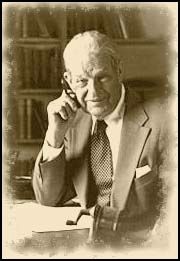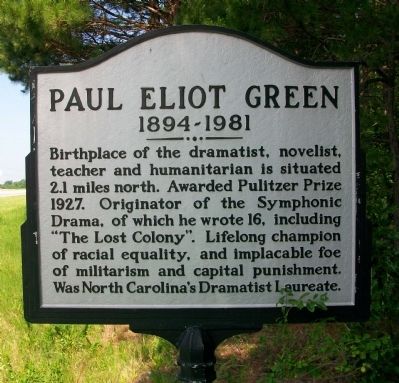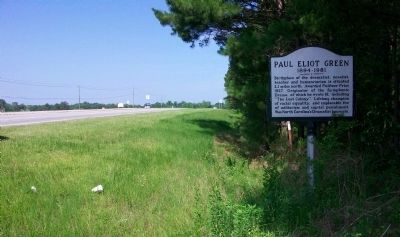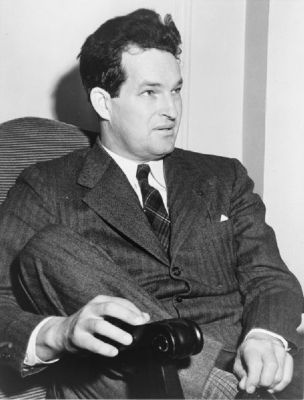Near Buies Creek in Harnett County, North Carolina — The American South (South Atlantic)
Paul Eliot Green
1894-1981
Topics. This historical marker is listed in these topic lists: Arts, Letters, Music • Civil Rights • Education • Entertainment. A significant historical year for this entry is 1927.
Location. 35° 24.454′ N, 78° 45.176′ W. Marker is near Buies Creek, North Carolina, in Harnett County. Marker is at the intersection of 421 (U.S. 421) and Johnson Farm Road, on the right when traveling west on 421. Marker is at the edge of the tree line, northwest corner of Hwy 421 and Johnson Farm Road. Touch for map. Marker is at or near this postal address: 4579 421, Lillington NC 27546, United States of America. Touch for directions.
Other nearby markers. At least 8 other markers are within 8 miles of this marker, measured as the crow flies. Campbell House (about 400 feet away, measured in a direct line); Campbell University (approx. ¾ mile away); Cornelius Harnett (approx. 3.3 miles away); Harnett County Veterans Memorial (approx. 3.3 miles away); Alexander Lillington (approx. 3.6 miles away); Robert B. Morgan (approx. 3.6 miles away); Alton Stewart (approx. 4½ miles away); Smiley's Falls (approx. 7.4 miles away). Touch for a list and map of all markers in Buies Creek.
Also see . . .
1. Wikipedia: Paul Green, Playwright. (Submitted on June 7, 2010, by Cleo Robertson of Fort Lauderdale, Florida.)
2. Paul Green: Dramatist, Teacher, Humanist (1894-1981). (Submitted on June 7, 2010, by Cleo Robertson of Fort Lauderdale, Florida.)
3. Documenting the American South: Paul Eliot Green. (Submitted on June 7, 2010, by Cleo Robertson of Fort Lauderdale, Florida.)
4. Internet Broadway Database: Paul Green, Writer, Lyricist. Listing of productions by Paul Green (Submitted on June 7, 2010, by Cleo Robertson of Fort Lauderdale, Florida.)
Additional commentary.
1. Paul Eliot Green
Paul Eliot Green (17 March 1894 - 4 May 1981) was an American playwright best known for his depictions of life in North Carolina during the first decades of the twentieth century. He received the Pulitzer Prize for Drama for his 1927 play, In Abraham's Bosom.
Born in Harnett County, near Lillington, N.C., Green was educated at Buies Creek Academy (known
today as Campbell University). He went on to study at the University of North Carolina at Chapel Hill where he joined The Dialectic and Philanthropic Societies. Green also studied at Cornell University.
Green first attracted attention with his 1925 one-act play The No 'Count Boy which was produced by the New York Theatre Club. The next year his full-length play In Abraham's Bosom was produced by the Provincetown Players and received the Pulitzer Prize for Drama. The play was considered remarkable for its depiction of African Americans in the South. Its hero, a man of mixed racial ancestry, finds his idealistic attempts to better the lives of the African Americans around him doomed to failure. With this success, Green quickly was recognized as one of the leading regional voices in the American theatre. His plays were often compared with the folk plays of Irish playwright John Millington Synge.
Green's tragedy of the decline of an old Southern family, The House of Connelly was chosen by the newly formed Group Theatre for its inaugural production. Often compared to Anton Chekhov's The Cherry Orchard in its contrast of aristocratic decay and parvenu energy, The House of Connelly was praised by critic Joseph Wood Krutch as Green's finest play to date.
But Green had already begun to move away from the realistic style of his early work. In 1928-29 he traveled
to Europe on a Guggenheim Fellowship and was impressed by the non-realistic productions that he saw there. He began to experiment with expressionism and the Epic theatre of Bertolt Brecht and Erwin Piscator. In the 1930s Green largely abandoned the New York theatre, whose commercialism he found distasteful. His experiments in non-realistic drama, Tread the Green Grass (1932) and Shroud My Body Down (1934) both premiered in Chapel Hill, and never were professionally produced in New York.
In 1936, Green returned to the Group Theatre with his pacifist musical play, Johnny Johnson, with a score by Kurt Weill. In it, Green experimented with genre, writing the first act as a comedy, the second as a tragedy, and the third as a satire. The production encountered problems of style early on: set designer Donald Oenslager designed the first act in poetic realism, the second in expressionism, and the final act in an extremely distorted style, director Lee Strasberg wanted to stage it realistically, and others in the company wanted it to be staged expressionistically throughout. Reviews ranged from the enthusiastic to the dismissive, and it ran for sixty-eight performances.
Green created a new dramatic form that he called symphonic drama. Inspired by historical events, it incorporated music and pageantry, usually for outdoor performance. His first experiment in this form was

Photographed By Unknown
4. Paul Green, Dramatist, Teacher, Humanist
Author Paul Green (1894-1981) was one of the South’s most revered writers, and one of America’s most distinguished. The first playwright from the South to gain national and international recognition, he was part of that remarkable generation of writers who first brought southern writing to the attention of the world.
Green's output was not only confined to plays. He penned the screenplay for the 1932 film The Cabin in the Cotton and also wrote extensively on the subject of his beloved North Carolina. He helped Richard Wright adapt his novel Native Son to the stage in 1940. He also was a founder of the North Carolina Symphony Orchestra and the Institute for Outdoor Drama. He served UNESCO travelling around the world to lecture on human rights and drama. Green served as a professor of drama at UNC until his death in 1981.
— Submitted June 12, 2010, by Cleo Robertson of Fort Lauderdale, Florida.
Credits. This page was last revised on April 6, 2023. It was originally submitted on June 7, 2010, by Cleo Robertson of Fort Lauderdale, Florida. This page has been viewed 1,697 times since then and 74 times this year. Last updated on April 5, 2023, by Michael Buckner of Durham, North Carolina. Photos: 1, 2, 3, 4. submitted on June 7, 2010, by Cleo Robertson of Fort Lauderdale, Florida. • J. Makali Bruton was the editor who published this page.


